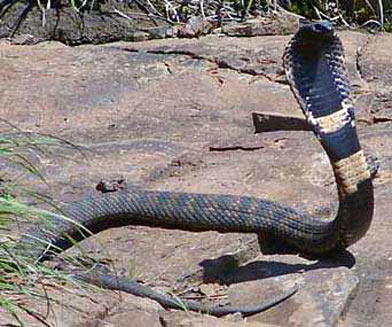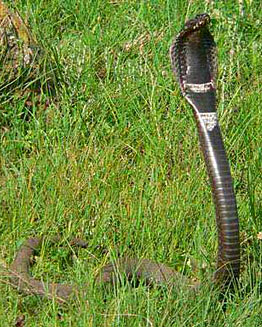|
Hemachatus haemachatus (Rinkhals, Ring-necked spitting
cobra)
Spuugslang [Afrikaans]; iPhimpi, uNobhiya [Xhosa]; iPhimpi,
uNobibi [Zulu]; iPhimpi [ Ndebele]; Kake [Tswana]; Petia [North Sotho]
Life >
Eukaryotes
>
Opisthokonta >
Metazoa
(animals) > Bilateria > Deuterostomia >
Chordata >
Craniata > Vertebrata (vertebrates) > Gnathostomata (jawed vertebrates) >
Teleostomi (teleost fish) > Osteichthyes (bony fish) > Class:
Sarcopterygii (lobe-finned fish) > Stegocephalia (terrestrial vertebrates) >
Tetrapoda
(four-legged vertebrates) > Reptiliomorpha > Amniota >
Reptilia (reptiles) >
Romeriida > Diapsida > Lepidosauromorpha > Lepidosauria >
Squamata > Serpentes
(snakes) > Family: Elapidae
 |
 |
|
Hemachatus haemachatus (Rinkhals, Ring-necked spitting
cobra), Free State. [photo A. Prozesky ©,from
SARCA
Virtual Museum] |
Hemachatus haemachatus (Rinkhals, Ring-necked spitting
cobra), Gauteng. [photo L. Verburgt ©,from
SARCA
Virtual Museum] |
 |
 |
|
Hemachatus haemachatus (Rinkhals, Ring-necked spitting
cobra), Mpumalanga. [photo G. Diedericks ©,from
SARCA
Virtual Museum] |
Hemachatus haemachatus (Rinkhals, Ring-necked spitting
cobra), Eastern Cape. [photo K. Webster ©,from
SARCA
Virtual Museum] |
Identification
This snake can be identified by the following, a dull
black or brown body (mostly in Gauteng) or a banded patterning elsewhere in its
distribution, 2 or 3 white bands on its hood, its keeled (rough scales) and its
ability to play dead.
Distribution and habitat
This snake species is widely distributed being found in the
Western Cape, Free State, KwaZulu-Natal, parts of Gauteng and throughout Lesotho and
Swaziland. It has a wide variety preferred habitats which includes grasslands,
savanna, low land forest, fynbos and has been known to regularly enter peoples
homes. It is also adept at climbing trees and can be found in both trees and
shrubs.
Food
It is known to feed on
toads, lizards,
rodents, other
snakes, birds and even
birds eggs.
Predators, parasites and disease
Fed on by
birds of prey (particularly
Secretary birds and
Snake eagles), other snakes and it seems
Bullfrogs are
particularly partial to young specimens, However its most serious threat is
habitat destruction.
Reproduction
This species is Viviparous (gives birth to live young) and
gives birth to between 20 and 30 ( although it can have as many as 60) young
during summer.
Longevity
Most likely 10 years or more when compared with the life
span of the similar cobra species ( Rinkhals are not true cobras)
Medical importance
The Rinkhals has potentially deadly neurotoxic venom that
will not as deadly as the Cape cobra could still kill a man. This snake also
unique because it is one of 3 snake species in South Africa that is able spit
its venom, despite this there are very few fatalities attributed to this snake
and in any case there is an effective antivenom. This snake is still
dangerous however because its venom can cause blindness when directed into the
eyes.
Links
References
-
Broadley, D.G. 1983. FitzSimons' Snakes of Southern
Africa. Delta Books, Johannesburg.
-
Marais , J. 2004. A Complete Guide to Snakes of
Southern Africa. Struik Publishing, Cape Town.
|
